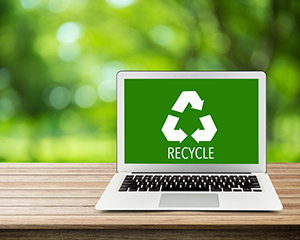Top Most Benefits of LCD Monitor Recycling

Featured Image: iStock.com/narith_2527
One of the best environmental friendly practices is the proper – and I mean ‘proper’ – recycling of old monitors and LCD screens which need an upgrade or downright replacement. Now most people think that just throwing out the decrepit stuff is enough to keep their personal space empty and clean. This approach is essentially wrong.
Eventually, we all come to an understanding of Justin Timberlake’s song “what goes around comes back around.” Or perhaps, we could explain it differently that it is nature paying back to us with what we threw at it in the past.
If you didn’t get my philosophical reflection, just don’t give up yet and read on till the end. You can get back to me with your questions or opinions in the space reserved for your comments.
• Why is LCD Monitor disposal so important?
Until and unless a user understands the dangers he is exposed to in his environment – because of an unusable device such as a worn out monitor or LCD – he won’t be able to improve his own getting-rid- of-eWaste practices. I don’t wanna give a long lecture, so just mentioning a few points one could easily remember. Here you go:
• LCD screen contains mercury which can be found in the small back light within the LCD monitor. It can be processed to safely recover the mercury.
• Each LCD monitor is evaluated to see if it can be refurbished and sold further to minimize the need for fresh production or usage of virgin material.
• If thrown away without proper disposal, CRT monitors and LCDs contain dangerous materials such as phosphorous, cadmium and mercury which has the ability to spread in open air.
• What is the process?
The process is simple yet requires expert and secure services for a complete disposal of electronic device. For recycling, we provide facilities in Philadelphia, New Jersey, Pennsylvania, New York, Maryland, Washington DC, and Connecticut for free. In our processing facilities, these screens are first dismantled and then recycled into basic commodities. Actually, the process is rather fascinating if you are a material junky like us. Let me take you through it in more detail:
When the monitors and LCD screens are collected from the customer, they are first sent to a facility where usable material is sorted among the unserviceable stuff. After that, it is sent to various departments to be sorted further and most of the elements (e.g. metals, such as, copper and steel) are smelted down and turned into raw material. Lead is extracted from smelted glass. Once the useful material is in raw form, it is then sent to another place to be given a new form, such as of a fresh product or a component to create something new.
• How beneficial or harmful is it for a company?
Recycling monitors and screens are beneficial for companies if they work with goodwill towards the betterment of environment. By stripping the devices of the dangerous materials and disposing everything off lawfully, companies not only build credibility in the hearts of the customers but also in the corporate world. Opting for an environment friendly business practice is the least you can do for humanity.
• Interesting facts about LCD Monitor Disposal
• To manufacture a monitor screen, it takes about 48 pounds of chemical, 539 pounds of fossil fuel, and nearly 1.5 tons of water.
• Most of the stuff considered “e-waste” does not qualify as waste material. It is, in fact, reusable and marketable in parts or whole immediately.
• About 85 per cent devices are disposed in landfills, which assists in the release of toxics into the air.
Conclusion:
All in all, it is advisable to every individual and corporation to opt for a professional electronic and IT recycling process. If you are one of the responsible citizens of Earth, tell us what you would do for a secure disposal of hazardous materials or share your story of e-waste recycling with us. If it’s inspiring, we might just feature it in one of our future posts.
Cheers!
About The Author Kelly Sampson
Kelly Sampson is a writer, blogger, and environmental enthusiast. She has strong opinions about climate change, the dogs vs. cats debate, and Oxford commas. She has lent Hummingbird International her engaging and spirited voice and turned our blog into a great place to find valuable information about e-waste, e-waste recycling, and the ITAD industry. Explore our blog to read more of her work.






